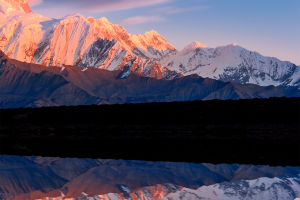When most people talk about an "ice age," they're usually referring to the last one that took place between 115,000 and 11,000 years ago.
During this period, the Earth's temperature was significantly lower than it is today, with the global average temperature being about 46 degrees Fahrenheit at the peak of the ice sheet covering most of North America. This is 11 degrees Fahrenheit lower than the current global average annual temperature.
Although this difference may not sound significant, it resulted in much of North America and Eurasia being covered by ice caps. The Earth also became drier, and sea levels were much lower because most of the Earth's water was trapped in ice sheets. Dry grasslands and deserts were very common.
So, how many ice ages has the Earth gone through in total? The Earth has experienced at least five glacial periods in total, with several ice ages and interglacial periods within each. From a glaciological perspective, a period of extensive ice cover in the northern and southern hemispheres is considered a major ice age. Given the existence of Greenland and North-South Extensive Ice Caps, the Earth is still in an interglacial period of the Quaternary Ice Age that began 2.6 million years ago in the Pleistocene. There is no indication that the Earth is emerging from this major ice age.
During glacial periods, temperatures dropped, altering the plant phase and the living environment on the Earth's surface, and many organisms faced extinction or were forced to migrate. Only species that could adapt to their environment survived.
Let's take a look at the five glacial periods in more detail:
1. Neogene glacial period
The Neogene glacial period, also known as the Huron glacial period, occurred between 2.4 and 2.1 billion years ago. It's named after the evidence of major ice sheet remnants found on the north shore of Lake Huron. It was probably the most severe and prolonged cold period on Earth.
Its cause may have been the Great Oxidation Event, which caused a dramatic increase in oxygen in the atmosphere, destroying methane and carbon dioxide, the major greenhouse gases in the primitive atmosphere. The end of the cold period laid the foundation for the emergence of eukaryotes.
2. Precambrian glacial period
The Precambrian glacial period, also known as the Igneous glacial period, occurred during the Neogene ice age, from 850 million years ago to 630 million years ago.
It was the coldest period on Earth in a billion years, with the polar ice caps extending to the equator, creating a snowball Earth, and the oceans completely frozen. The gradual accumulation of carbon dioxide from volcanic eruptions due to the inability of Earth's organisms to photosynthesize eventually created a greenhouse effect that brought the Earth out of the ice.
3. Early Paleozoic glacial period
The Early Paleozoic glacial period, also known as the Andean-Saharan glacial period, spanned a smaller period of time, appearing in the Late Ordovician and Silurian periods of the Paleozoic Era, from 460 million years ago to 430 million years ago.
4. Late Paleozoic glacial period
The Late Paleozoic glacial period, also known as the Great Karoo Ice Age, occurred at the end of the Paleozoic Era during the Carboniferous and Permian periods, from 360 million to 260 million years ago. It is named after the evidence of ice caps found in the Karoo region of South Africa.
5. Quaternary glacial period
The Quaternary glacial period, or Pleistocene glacial period, current glacial period, or just glacial period, began 2.58 million years ago in the late Pliocene (another theory says it began 20 million years ago when permanent ice caps appeared on the Antarctic continent) and continues today.
During this major ice age, the Earth was in a cycle of alternating ice ages and interglacial periods. Currently, the only continental ice caps on Earth exist in Antarctica, Greenland, Baffin Island, etc.


